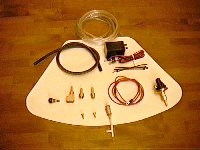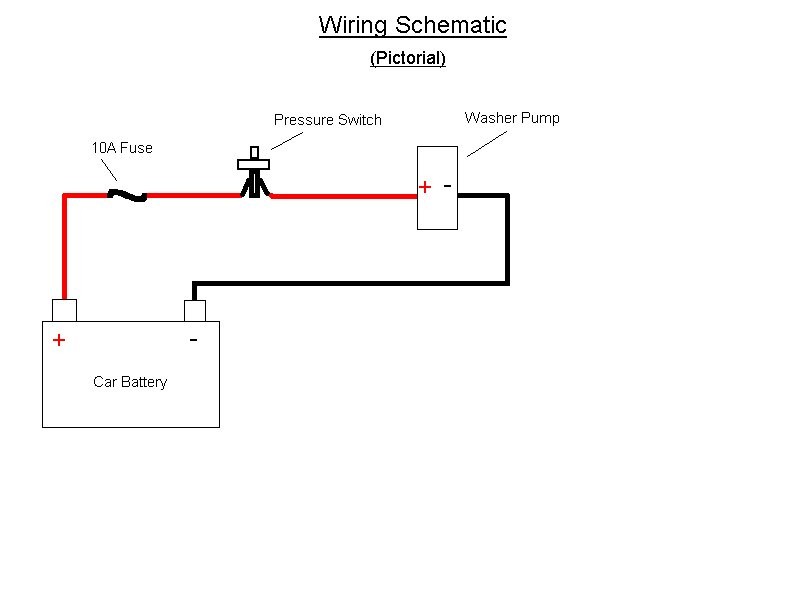For specific instructions on installing Dawes Devices MBCs and other products, use the buttons below.
DIY Water Injection
In the early days of Dawes Devices, we experimented extensively with creating a water injection kit that could be built for fraction of the cost of a purchased system, but would work just as well. This page was the most popular entry page at our old web site. The original system was designed to work with a non-intercooled Dodge Daytona* and so, some of the specific information may not apply to all vehicles. Also, some of the specific part numbers have changed since the article was written in 1999. However where possible, we have updated the part numbers with Amazon links. Look for the links after each part description.
*Note that this system was designed to be used BEFORE the turbo and as such, uses a low pressure pump. However, the system can be adapted to inject AFTER the turbo, by the addition of a high pressure pump, such as the Shurflo types available HERE, on Amazon.
This article is presented in three parts. The “Overview” , the “How To” and then the “Installation Instructions”. At some point we’ll try to combine them, but if you just read down the page, you’ll get them in the intended order. Enjoy!
–Darren Dawes
P.S. Don’t bother emailing us to warn that injecting before the turbo will erode the turbo compressor blades etc. We appreciate your concern. However we used this system for over 50K miles with distilled water or water and alcohol and have found this particular myth to be just that–a myth.
DIY (Do-It-Yourself) Water/Alcohol Injection System and Intercooler Sprayer

The original “kit”, no longer for sale (because you can build your own for less!)
In the interest of benefiting our fellow turbo enthusiasts, we have decided to provide a “how-to” and parts list to construct your own budget, water injection system.
We’re sorry, but despite multiple references to the “kit”, we no longer offer one for sale.
Note: Please read the FAQ and how-to section, carefully. Dawes Devices cannot be held responsible for damage occurring from misuse or non-compliance with the anti-siphoning guidelines.
Water Injection Facts:
When increasing the boost level of a turbocharged vehicle, an undesirable byproduct is an increase in intake temperatures as well as a corresponding increase in combustion temperatures.. These higher intake temperature increase the chance of detonation within the cylinder. The best solution is to add an intercooler when the boost pressure exceeds 12 psi, but this is not always practical due to cost and packaging limitations. The early Chrysler TI (drawthrough) turbo engines are a good example of packaging limitations. It is somewhat difficult to fit an aftermarket intercooler to the factory manifold. This makes it a good candidate for water injection.
Water injection decreases the possibility of detonation by lowering the combustion chamber temperatures and increasing the effective “octane” of the fuel. This allows the engine to run a higher boost and full spark advance without the use of race gas. Additionally, if the water is atomized in the intake stream, there is an additional cooling of the intake charge. Both effects are increased with the inclusion of 50% alcohol to the mix (don’t spray the exterior of an intercooler with alcohol!, this refers to internal injection only). The additional fuel of the high octane alcohol will in turn allow boost beyond what the factory fuel system can deliver.
Water injection also has the effect of “steam cleaning” the combustion chambers and exhaust valves. This removes the carbon build up that decreases efficiency and leads to pre-ignition (detonation). It will also keep the throttle body and interior of the intake manifold much cleaner than normal.
Water Injection FAQ
-An 1/8 in pipe thread tap for the water fitting to your washer tank as well as the appropriate drill bit ($6 for both at the hardware store)
-Optional—you may wish to use a solenoid valve to cut off water flow when the system is idle. We provide a siphon block to provide this function, but it must be mounted above the washer tank. In some applications it is more practical to use a solenoid valve. You can get one for a couple bucks at the boneyard. The boost control solenoid, from the passenger side fender of most Dodge turbo cars works great. We do not supply solenoid valves due to the high cost of a “new” unit.
-Optional—I prefer to use the washer tank as my water supply, but you may want to use a separate tank.
-A switch to turn the system on.
Water/Alcohol Injection
“How-to”
I originally began this project to help someone with an early Chrysler T1 who did not want to go through the trouble of intercooling. The goals were to suppress detonation at high boost (15-18psi), on pump gas, while spending as little money as possible. For details of how water injection does this, read the page that brought you here. This system is not solely designed as a means to increase fuel flow. At one time, I intended to offer this system in kit form. However, in keeping with the “budget” nature of this project, I can not use some of the better components that my customers expect. By providing this how-to page, I intend to clearly illustrate how you can duplicate this system yourself. Note that you may upgrade the components as you budget allows, to increase the durability of the system, but the “budget” model works just fine.
- The nozzle
- The pump
- The tank
- !! THE SIPHON BLOCK !!
- The filter
- The fittings and tubing
- The activation switch
- The fuse
- The water/alcohol mix
- Results
Update 2014: Here is a link to the Trico pump, on Amazon. There are lots to choose from if you want something better.
Update 2014: Link: You can now buy tanks on Amazon and some (like this one) come WITH a pump!
Update 2014: You can get the anti siphon check valves on Amazon, here.
Update 2014: I’ve got some really nice silicone hose for sale at Dawes-Devices.com. Here is the link.
UPDATE 2014: There is a better, adjustable pressure switch available on Amazon. You can find it at this link.
Update 2014: Amazon to the rescue again, with a waterproof fuse holder for 3 bucks. Here’s the link.

Hose Layout for Before Turbo Water Injection

Wiring Diagram for Water Injection
Water/Alcohol Injection Installation Instructions
Please read all instructions before beginning.
- Washer tank modification
- Pump installation
- Switch Mounting
- Wiring
- Misting nozzle installation
- Testing the system
- !! SIPHON BLOCK !!
- Experimenting
